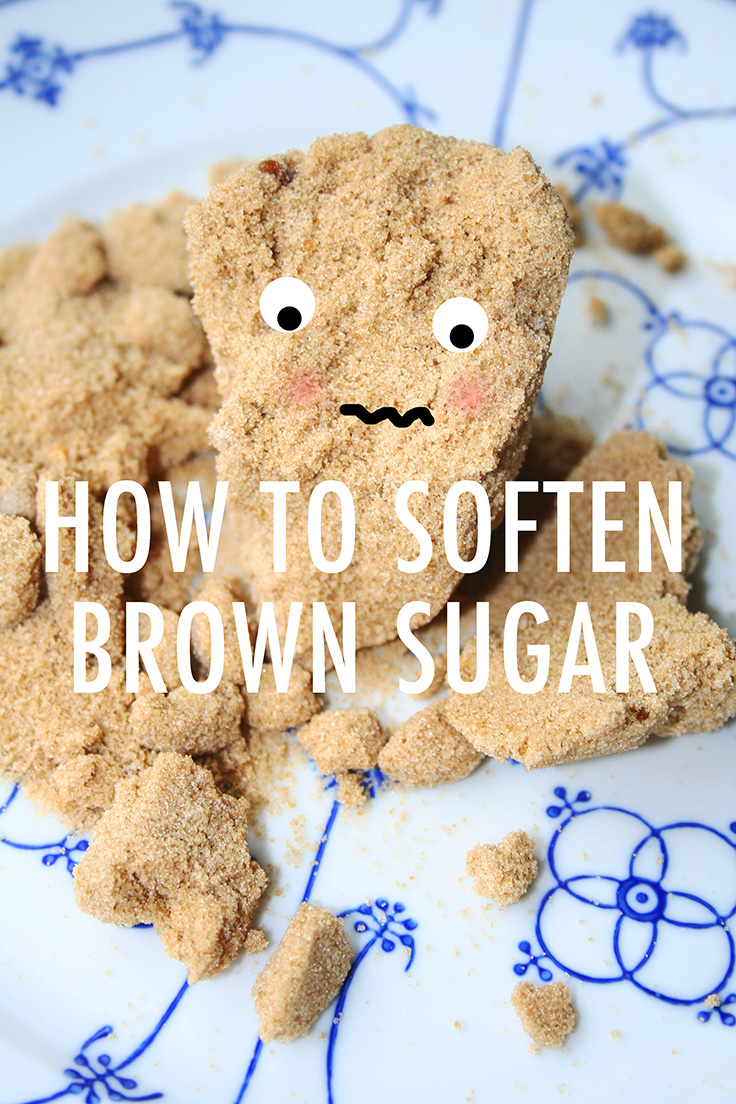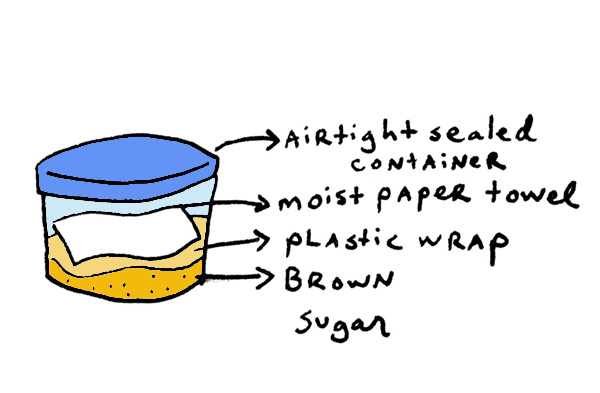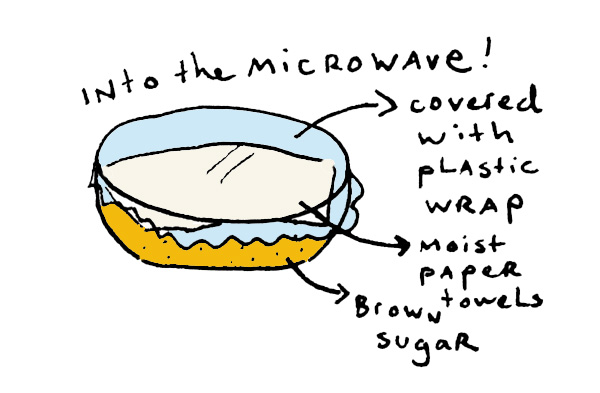Picture this: you’re measuring out your ingredients before embarking on a cooking or baking adventure, but when you get to the bag of brown sugar, it appears to have hardened into a solid, rock-like substance. Chances are, if you’re a frequent baker, you’ve found yourself in this situation. But can this problem be remedied? Happily, the answer is yes — there are a few tried and true tricks to bring brown sugar back to life.

Is your brown sugar as hard as a rock? Here are some simple solutions to bring it back to life.
Photos and illustrations via CakeSpy
To understand these methods, we need to know why brown sugar hardens.
Unlike regular granulated sugar, brown sugar is enriched with molasses, which lends a unique flavor but also gives brown sugar that unique moist quality. It’s when the brown sugar loses that moisture and becomes dried out that the sugar becomes hard.
Therefore, to revive brown sugar, it’s a matter of returning the moisture to the sugar, which will make it soft again.
Knowing this helps make the sometimes unusual methods make a little more sense: basically, they are all designed to re-introduce moisture into the mixture. Here are a few different ways to soften brown sugar, depending on how much time you have.
1) If you have 2 to 3 days:

About these methods:
If you have a few days to revive your brown sugar, your results will be longer-lasting. The moisture is re-introduced to the sugar gradually, and the sugar will remain soft for as long as you keep it in an airtight container.
How to do it:
Place the hardened brown sugar in an airtight container. Before putting on the lid, cover the sugar with a sheet of plastic wrap (to form a slight barrier). On top of this, place a piece of damp (but not dripping) wet paper towel. Place the lid on container and seal tightly. After two to three days, the sugar ought to have absorbed the moisture, and you should be able to stir it with a fork and separate it. Keep in the airtight container; the sugar should remain soft.

Variation:
Repeat the above steps, but instead of wet paper towel, insert either a slice of bread or an apple slice (it’s OK to have up to half an apple, cut in slices so they’ll fit). Why white bread? Because it’s moist, it will add some humidity to the mixture which will re-moisten the sugar; also, because white bread is fairly bland, it will not impart a strong flavor on the sugar. Why apple? Like the bread, the moisture in the apple will re-moisten the sugar, and the flavor imparted is generally harmonious with brown sugar and will taste good with items baked with brown sugar (as opposed to a more assertive flavor like lemon).
2) If you have about 20 minutes:

About this method:
This method is quick and efficient, but it requires care as you will be working with hot sugar and don’t want to burn yourself. Because the sugar will harden again once it cools, it is best to use sugar softened in this method right away.
Oven method:
If you need to use your hardened brown sugar fairly soon, preheat your oven to 250 F. Remove the brown sugar from the package and transfer it to an oven-safe baking dish that has a little room so the sugar won’t fly when you break it up once you remove it from the oven.
Once the sugar is in the oven, monitor it closely, checking it every couple of minutes. You will start to notice its texture beginning to soften. Remove from the oven and test breaking up the brown sugar with a spoon. If it is soft enough, measure the amount you need right away. Be extremely careful while measuring because the sugar can get quite hot. But do not wait for the sugar to cool, because unlike the 2-3 day method, the sugar will re-harden rather rapidly after this method.
3) If you need it right now:

About this method:
This method is effective and very fast, but the results aren’t quite as even as the above two methods. Like the oven method, the sugar will re-harden after being revived in this method, so the softened sugar is best used right away.
Remove the brown sugar from the package. If the sugar has formed into a big brick in the bag, you may want to break it up a bit, as you would a large piece of ice. Place it in a microwave-safe bowl with ample room so that that has a little room so the sugar won’t fly when you break it up once it comes out of the microwave.
Cover the sugar with two pieces of moist (not dripping) paper towels. On top of the paper towels, cover the bowl with microwave-safe plastic wrap. Heat on high in the microwave in 30 second increments until it has become soft. This can vary depending on your microwave and how hard the brown sugar has become. Remove from the microwave and stir with a fork, but be careful, because the sugar may be rather hot. Like the oven method, take care with the hot sugar but measure it as quickly as possible, as the sugar re-moistened in this method will re-harden rapidly as the sugar cools.
Note: Don’t like the idea of using plastic wrap in the microwave? This method can be completed with just the moist paper towels. However, since the moisture won’t be sealed quite as efficiently as with the plastic wrap, pause and stir the brown sugar after each microwave heating increment to ensure that the mixture can be heated and moistened as evenly as possible.
How to avoid hardened brown sugar
Although hardened brown sugar is a fairly common kitchen complaint, it really need not be a problem. There are some preventative measures you can take to keep it moist longer.
Store in an airtight container
Instead of leaving the sugar in the bag in which you purchased it, transfer your brown sugar to an airtight container. This will help seal in the moisture and make it last longer.
Store in the freezer
Another method is to store brown sugar in the freezer and let it thaw overnight or several hours before baking. If you decide you need some of the chilled sugar right away, you can heat it in the microwave (no paper towels or plastic wrap needed) to thaw it out quickly.
Note: For ease of use, you can divide the brown sugar into common baking quantities such as half or one cup portions before you freeze.
Make your own brown sugar to order
Your brown sugar will always be fresh if you make it yourself. Check out our easy tutorial on how to make brown sugar at home using granulated sugar and molasses.
You might also enjoy our recipe for irresistible brown sugar buttercream.

Share tips, start a discussion or ask one of our experts or other students a question.
No Responses to “Top Secrets for How to Soften Brown Sugar 3 Different Ways”